Hello there,
Today we are going to dive into the land of the Glute muscles, the problems they can cause, and simple ways to care for them at home!
It often surprises my clients to hear that the Glutes are the largest muscle group in the body. Even those of us who don’t feel especially bootyful. Their density and thickness also make them one of the strongest muscle groups. Because of this strength, tension or imbalance within the Glutes can cause problems that are a true pain in the bum, the back, the legs/feet, and sometimes even the noggin.
Before going into some of the troubles involved with the glutes Ima get nerdy on you and talk a little about the anatomy of these muscles and their function.
The muscles in your bottom are made up of the: Gluteus Maximus, Gluteus Medius, Gluteus Minimus, Piriformis, Gemellus Superior, Obturator Internus, and Gemellus Inferior. That’s a lot of Latiny words to say there’s a buttload of muscles up in there! To keep things simple we’ll call them collectively “The Glutes” and they work together to do a great job of stabilizing, extending, and laterally rotating your hips. This includes movements like: standing from a seated position, going up stairs, lifting from a squat, turning your feet out (duck waddle), and so many more. The Glutes are involved in any large movement of the body and fast paced movements like exercise or dance.
The photo on the left shows the Gluteus Maximus and Medius which are directly under the skin and subcutaneous tissue. If you were to lift Glute Max, you would see the musculature displayed in the photo on the right.
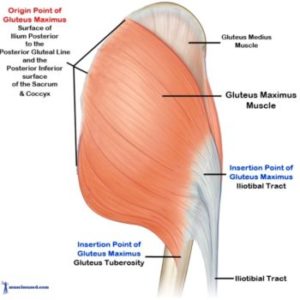
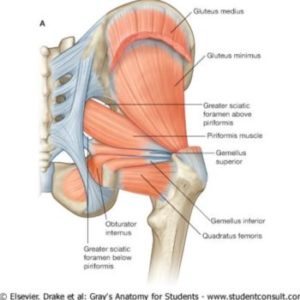
Now that you’ve been nerded a little let’s get into some of the problems that can arise with tight/imbalanced glute muscles.
We’ve all heard the term “Sciatica” before or you’ve been unlucky enough to feel this sensation. Sciatica is a term used to describe tingling or pain travelling down the leg from the glutes/low back. There is a whole range of conditions that can cause this type of pain from herniated discs to unique anatomical cases but some individuals are healthy and still struggle with this type of pain. If this is you, surprisingly often, this “sciatic-like” pain comes from overly tight Glute muscles. Specifically tension in the Piriformis muscle, which we term “piriformis syndrome”. Piriformis syndrome causes the same sensation and pain as Sciatica. This is very common in individuals who: have desk jobs, spend lots of time driving, perinatal women, athletes with a recent strain/injury, or following a car accident. Often this tension builds over time so it can seem as if the pain comes out of nowhere. In some cases of severe Glute tightness the numbness and tingling can extend down into the feet and toes or up the spine contributing to tension headaches. Keeping the Glutes strong and limber is so important for long term wellness.
For most people, there are subconscious movements each day that contribute and even cause this tension. Ie: always crossing the same leg over when sitting at your desk, using one leg more than the other when you stand up, leading with one leg during running, moving more forcefully with one side during strength training, leaning on one hip while you stand in the grocery store line, etc.
There is so much involved with the hips when we look at the deep abdomen and quad muscles but for today we’ll keep things simple and go over the 3 most effective stretches I’ve found for these muscles. Otherwise I’ll get too cray on you with my nerdery.
In each of these stretches there are a few things to focus on:
- Find a point of stretch that is Comfortable
- Inhale and exhale deeply in a Relaxed way
- Ensure there is no pain in other areas of the body due to pressure (knees, ankles, neck etc.)
I recommend holding a stretch for at least 5-10 slow deep breaths instead of timing a stretch. Each breath brings oxygenation and the muscles will relax more effectively. Sometimes we lose focus on the breath when we watch the second hand of a clock.
*For prenatal clients in the third trimester, don’t go to a full point of stretch, back off a little from where your maximum stretch is.*
1. The Seated Glute Stretch:
This is the most gentle way of stretching these muscles. It’s a great option for individuals with extremely tight hips, pregnancy, or arthritis. If you notice your knee is quite high it’s a sign the hips are very tight. Gently put some pressure with the palm of the hand on the top of the knee to bring it down and intensify the stretch slightly. If you have any pain allow the knee to rest at it’s natural higher position without adding any pressure to it. Another way to deepen the stretch is to lean forward slightly while keeping the back straight. This is a great option for during the day at work and I recommend doing it 2-3 times throughout your day to notice results.
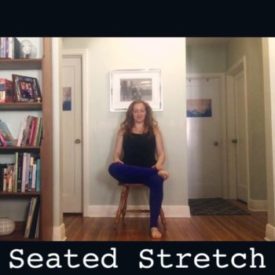
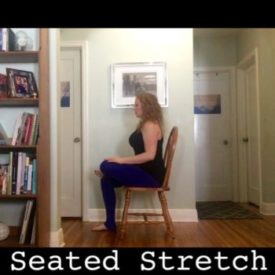
2. The Reclined Glute Stretch:
This is a wonderful stretch for all levels but is great for getting into a deeper stretch while staying very relaxed. I recommend this version for morning and night, with waking and just before bed. You may have seen/done this stretch with the arms wrapped around the legs for support. That version is fine if you don’t have the space to use a wall or for a shorter duration.
Using the wall for support is effective for 2 reasons; it allows the rest of the body to relax, and it allows a slow shift in angles to access the different muscle groups in the hips. When you look at the anatomy diagrams above, you see each of the muscles have slightly different angles out from the Sacrum (tailbone). When we stretch the Glutes in these 3 positions a more complete release of the hips takes place.
Begin by scootching your bottom close to the wall. The closer to the wall, the deeper the stretch will be. Cross your leg over and be aware of the position of your knee, as with the seated stretch, try bringing it down slightly if it is comfortable to do so. The arms can rest at your sides or straight out for a gentle chest/bicep stretch. Once you are comfortable with the depth of your stretch settle into the first position and breath for 5-10 deep breaths, or as long as you like. For the second position, shift towards the knee (in this case my right hand) slowly. Both Glutes should contact the floor and the shift will probably only be a couple inches. Pay attention to what you feel in the Glutes and see if you notice a difference in the stretch. After holding here, shift through center and then towards the other side. In most cases this will be the most challenging angle which is why we leave it until the other muscles have loosened up a little. Again, the shift will be quite small but you should notice a difference where you feel the stretch. When finished with the third position, move out from the wall a little before releasing the knee down slowly. Take a couple moments and then repeat with the other leg.
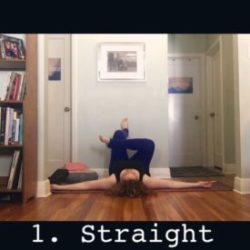
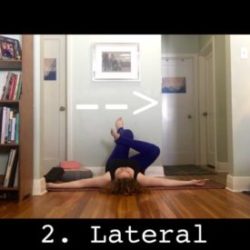
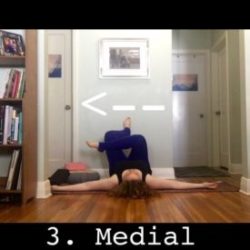
3. Cow Face Pose or Cow Legs:
This is a deeper stretch for the Glutes and hips. It takes flexibility but is a good option for those needing more than the first 2 stretches. There are a few different ways to get into this position. I’ll just go over one option but there are lots of videos on Youtube if you want to see it in action. Begin by sitting with your legs straight out in front of you then bend your knees and put your feet on the floor. Slide your left foot under the right knee to the outside of the right hip. Then cross your right leg over the left, stacking the knees one over the other, and bring the right foot to the outside of the left hip. Try to bring the heels equal distance from the hips: with the right leg on top you’ll have to gently bring the right heel closer to the left hip. Do your best to sit evenly upon both sides of your bottom. Make sure to keep your chest lifted and your spine straight as you breathe deeply for the duration that is comfortable for you. Ease out of the stretch slowly before reversing legs. 
Stretching and self-care is a big part of rehabilitating this type of tension. A massage is great but taking time at home is equally, if not more, important. It helps you develop more self-awareness in these areas. When you’re standing in line at Sobey’s leaning on that right hip, you’ll feel it and correct it more quickly if you’ve stretched earlier in the day. These little corrections make a whole lotta difference over time and I’ve always felt it’s important for my clients to have tools to use at home. It keeps progress moving forward after a session and it is Empowering to know that you have an equal part in your own recovery.
In a future post we’ll talk about caring for Quads/IT Bands/Hip Flexors and how they are closely linked with improvement in the Glutes.
I hope these stretches help your hips feel more open, whether you’re struggling with pain or tension. Feel free to contact me directly with any questions or for modifications of these stretches!
*In cases of disc herniation or more serious conditions, the techniques can still be of benefit to ease the tension of the muscles surrounding your injury. However, always check with your medical provider before trying new stretches and listen to your body as you go through the movement.*
Have a wonderful weekend,
Francie